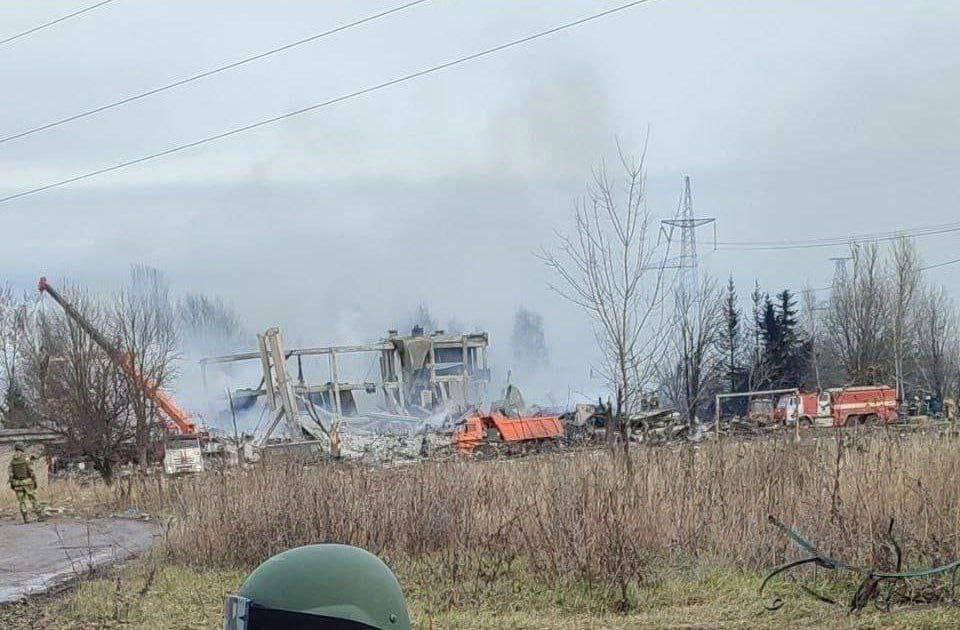At approx. 07:00 UTC+3 a fire was reported at the airfield in #Kursk [#курск ] where a suspected - and later reported - drone attack occurred.
This comes less than 24 hours after suspected drone attacks on Engels and Diaghilev airbases.
a/v s: t.me/gistapapapa/54…
1/N
This comes less than 24 hours after suspected drone attacks on Engels and Diaghilev airbases.
a/v s: t.me/gistapapapa/54…
1/N
The Governor of Kursk, Roman Starovoit, does report that the fire is the result of an #UAV attack, on airbase oil/fuel infrastructure specifically, and that the fire is localized.
s: t.me/gubernator_46/…
2/
s: t.me/gubernator_46/…
2/

The fire location is consistent with fuel tanks and pumping infrastructure in the northeastern quadrant of the airbase.
The specific source involved (infrastructure) of the fire is unclear.
IVO: 51.752013 N, 36.306151 E
s: t.me/kurskadm/40868
s: t.me/opersvodki/114…
3/


The specific source involved (infrastructure) of the fire is unclear.
IVO: 51.752013 N, 36.306151 E
s: t.me/kurskadm/40868
s: t.me/opersvodki/114…
3/



Interestingly, reactions among the Russian public are what would be expected: exasperation.
Earlier suspected drone attacks at Engels and Diaghilev, as well as other long-range attacks, leave them expressing curiosity, disappointment, and rage.
s: translations only.
4/



Earlier suspected drone attacks at Engels and Diaghilev, as well as other long-range attacks, leave them expressing curiosity, disappointment, and rage.
s: translations only.
4/




Notably, the comments quickly turn to sourcing blame, with upper Russian political and military leadership aimed at first.
Note: this is a minimal sample of reactions, but among the first responding to the event.
s: translations only.
5/


Note: this is a minimal sample of reactions, but among the first responding to the event.
s: translations only.
5/



Translation notes:
Zadolbali [Скучающий]: one who easily irritates you, gets on your nerves.
Observation on this event and its outcomes will continue.
s: t.me/kurskadm/40869
6/
Zadolbali [Скучающий]: one who easily irritates you, gets on your nerves.
Observation on this event and its outcomes will continue.
s: t.me/kurskadm/40869
6/

The reported UAV attack is having an immediate affect on the perception of safety in Kursk.
Gov. Roman Starovoit declares an extension of "yellow" terrorist threat level.
s: t.me/kurskadm/40870
7/
Gov. Roman Starovoit declares an extension of "yellow" terrorist threat level.
s: t.me/kurskadm/40870
7/

The "yellow" threat level is mid-level of a three-tiered system, where "red" is 'critical' (highest).
"Yellow" equates to increased security patrols, military and police checkpoints, and intelligence apparatus presence.
Their effect on air-based threats is likely minimal.
8/
"Yellow" equates to increased security patrols, military and police checkpoints, and intelligence apparatus presence.
Their effect on air-based threats is likely minimal.
8/
For reference on the severity of the fire, there is a claim that fire-trains have been dispatched.
Note: there is a rail line accessing the airbase to the north, but fire-trains are likely involved to deliver foam in large quantities.
s: t.me/kurskadm/40871
9/

Note: there is a rail line accessing the airbase to the north, but fire-trains are likely involved to deliver foam in large quantities.
s: t.me/kurskadm/40871
9/


Fire Location confirmed at northern end of airbase affecting 1 to 2 vertical tanks and nearby pumping infrastructure.
s: t.me/Tsaplienko/221…
10/
s: t.me/Tsaplienko/221…
10/

Impacts of the attacks on airfield(s) are taken seriously. Specifically, diminishing returns from Russian missile strikes, and an increase in Ukraine's capacity to strike long-distance targets within Russia.
This concludes observation of th event.
12/12
This concludes observation of th event.
12/12
https://twitter.com/wartranslated/status/1600086873711386624?s=20&t=I_5lD4sM_aOVwvPYyoKd4w
• • •
Missing some Tweet in this thread? You can try to
force a refresh











